 |  |  |  |  |  |  |  |
 |  |  |  | INBMA |  |  |  |
Sondahl's Crystalline Glaze Color tests
 |  |  |  |  |  |  |  |
 |  |  |  | INBMA |  |  |  |
Using my standard crystalline Cone 9-10 base, I tested
5 common colorants, and their combinations. All the tests included
rutile, since some titanium is desirable for seeding the crystals, but
by itself it yielded a white background with gold crystals.
These are the recipes:
| A | B | C | D | E | |
| Frit P25 | 28.4 | 28.4 | 28.4 | 28.4 | 28.4 |
| ZnO | 25.25 | 25.25 | 25.25 | 25.25 | 25.25 |
| Flint | 12.9 | 12.9 | 12.9 | 12.9 | 12.9 |
| Potash
Feldspar |
22.7 | 22.7 | 22.7 | 22.7 | 22.7 |
| Whiting | 3.1 | 3.1 | 3.1 | 3.1 | 3.1 |
| Kaolin | 5 | 5 | 5 | 5 | 5 |
| Rutile | 2 | 2 | 2 | 2 | 2 |
| CuC | 3 | ||||
| CoC | 2 | ||||
| Mn02 | 3 | ||||
| RIO | 3 |
Note: When combining these glaze samples, an equal volume
of glaze was added of each. The resulting glaze thus is diluted to
one half of the strength of colorant.
That is, combining B and C above, the recipe would have
1.5 grams CuC and 1.0 grams of CoC (all the ingredients above these two
are the same).
When viewing the tiles, consider that glaze application of small tests inevitably varies. In general, whether crystals were plentiful or not mostly depended on the thickness of the glaze. These tests were to show color response more than crystalline growth. They were all fired on the same shelf in the kiln, at the Cone 9-10 range.
In each group of tiles below, the first is the pure colorant
represented by the code letter, then the other combinations are shown.
I liked a number of the tests. Manganese made a
lovely warm beige, but I tend to shy away from using it much, partially
from the gasses it gives off in firing, which have become a health concern
in recent years.
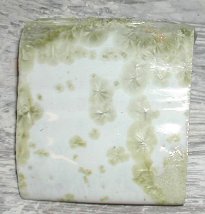 H65A
H65A 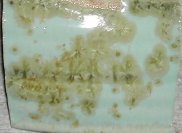 H65AB
H65AB 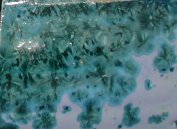 H65AC
H65AC 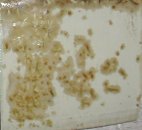 H65AD
H65AD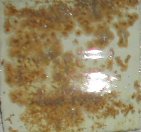 H65AE
A=Rutile B=Copper Carb. C=Cobalt Carb. D=Manganese Diox. E=Red Iron
Oxide
H65AE
A=Rutile B=Copper Carb. C=Cobalt Carb. D=Manganese Diox. E=Red Iron
Oxide
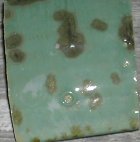 H65B
H65B 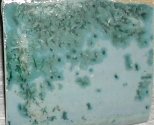 H65BC
H65BC 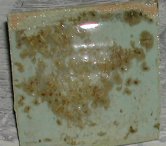 H65BD
H65BD 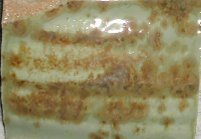 H65BE
H65BE
 H65AB
A=Rutile B=Copper Carb. C=Cobalt Carb. D=Manganese Diox. E=Red Iron
Oxide
H65AB
A=Rutile B=Copper Carb. C=Cobalt Carb. D=Manganese Diox. E=Red Iron
Oxide
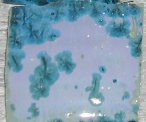 H65C
H65C 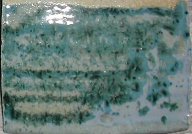 H65CD
H65CD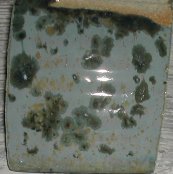 H65CE
H65CE  H65BC
H65BC
 H65AC
A=Rutile B=Copper Carb. C=Cobalt Carb. D=Manganese Diox. E=Red Iron
Oxide
H65AC
A=Rutile B=Copper Carb. C=Cobalt Carb. D=Manganese Diox. E=Red Iron
Oxide
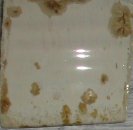 H65D
H65D 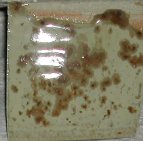 H65DE
H65DE  H65AD
H65AD  H65BD
H65BD
 H65AD
A=Rutile B=Copper Carb. C=Cobalt Carb. D=Manganese Diox. E=Red Iron
Oxide
H65AD
A=Rutile B=Copper Carb. C=Cobalt Carb. D=Manganese Diox. E=Red Iron
Oxide
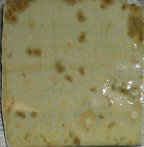 H65E
H65E  H65AE
H65AE  H65BE
H65BE  H65CE
H65CE
 H65DE
A=Rutile B=Copper Carb. C=Cobalt Carb. D=Manganese Diox. E=Red Iron
Oxide
H65DE
A=Rutile B=Copper Carb. C=Cobalt Carb. D=Manganese Diox. E=Red Iron
Oxide
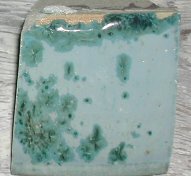 H65ABC
H65ABC 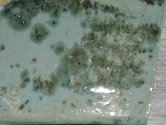 H65BCE
Other multiple combinations were tested, but not impressive.
H65BCE
Other multiple combinations were tested, but not impressive.
Because Copper is a strong flux, some of the tests with Copper ran off the tiles (always a possibility with crystalline glazes). The Copper tile was the only glaze with some cratering, probably caused by glaze boiling. If you wanted a green glaze, I'd consider dropping the whiting if you're using Copper.
Brad's crystalline primer page
 |  |  |  |  |  |  |  |
 |  |  |  | INBMA |  |  |  |